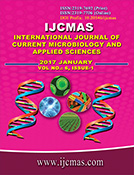


 National Academy of Agricultural Sciences (NAAS)
National Academy of Agricultural Sciences (NAAS)

|
PRINT ISSN : 2319-7692
Online ISSN : 2319-7706 Issues : 12 per year Publisher : Excellent Publishers Email : editorijcmas@gmail.com / submit@ijcmas.com Editor-in-chief: Dr.M.Prakash Index Copernicus ICV 2018: 95.39 NAAS RATING 2020: 5.38 |
The crude hexane, ethyl acetate and aqueous leaf extracts of medicinal plant Wrightia tinctoria R.Br. were evaluated for in vitro antimicrobial activity against selected bacterial and fungal strains. Preliminary phytochemical screening of the three crude leaf extracts revealed the presence of phenols, alkaloids, tannins, flavonoids, terpenoids and sterols. The extracts were screened against three Gram positive strains (Bacillus subtilis, Bacillus licheniformis and Streptococcus pneumoniae), two Gram negative strains (Escherichia coli and Sphingomonas sanguinis) and against three fungal strains (Aspergillus flavus, Aspergillus niger and Candida albicans). Antimicrobial activity of these crude extracts was determined using Agar well diffusion method. Agar broth and Potato dextrose broth dilution method was used to determine the minimum inhibitory concentration. Ampicillin and Flucanazole were used as standards for bacteria and fungi respectively. The results of in vitro antimicrobial activity showed that hexane, ethyl acetate and aqueous crude leaf extracts were active on all microbial strains tested at different concentrations, with hexane leaf extract exhibiting more activity. Results obtained from the present study showed that the leaf extracts of Wrightia tinctoria R.Br. have considerable antimicrobial activity and hence, they may be used for further extraction and isolation of antimicrobial compounds which may find a place in medicine industry as constituents of antibiotics.
 |
 |
 |
 |
 |